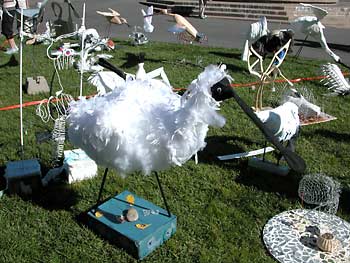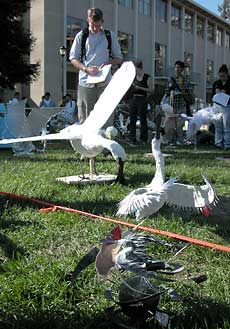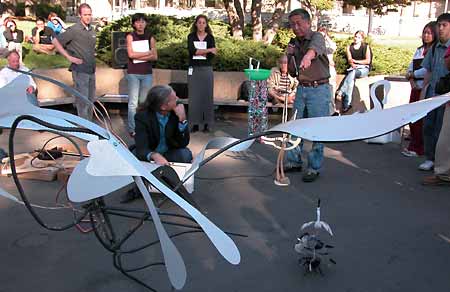 |
Part of the flock of black-faced spoonbill yard ornaments – some graceful, some whimsical – that descended on the Kroeber Hall lawn for the student sculpture competition. (Steve McConnell photos) |
The 7th annual spoonbill migration
BERKELEY – About five years ago, University of California, Berkeley, Professor Randolph Hester sat in Nankanshun, one of the most popular temples in Taiwan, with a couple of questions for the temple god.
The professor of landscape architecture and environmental planning was in the early days of an effort to save the endangered black-faced spoonbill, whose migratory route each winter takes about half of its population of 800 to Tainan, Taiwan's Tsengwen wetlands. He wondered what the future held.
"I asked the god of this temple if we would stop the Bin-Nan proposed petrochemical and steel plant project that threatened the spoonbills' habitat, and would the spoonbills reach a sustainable population," said Hester.
Following tradition, he tossed two pieces of wood into the air and used a guide to interpret their pattern when the sticks fell to the floor. The answers? Affirmative to stopping Bin-Nan, but "not in my lifetime" to the sustainability question, Hester said.
 Students in Environmental Design 1 rate their peers' sculptures. The designs ranged from small and delicate to very large and, well, not at all delicate. |
"To save that bird is a never-ending struggle," he said recently, but added that he and his students have no intention of giving up. Along with engineers, scientists, members of the high tech community, and students, faculty and staff from UC Berkeley and the National Taiwan University, they comprise SAVE International, a group fighting to save the birds.
This Thursday, Hester and students in his beginning environmental design course have arranged for a flock of about 150 spoonbills to arrive just outside UC Berkeley's Kroeber Hall. The birds will actually be the students' creations - homework Hester has assigned for seven years in a row.
The birds, in the form of durable lawn ornaments, will be about the same size as the spoonbill - 2-by-3-by-4-feet. Students' designs will capture the bird's flight or movement, funny feeding patterns, elegant form and color - or the agony of extinction or battles between habitat preservation and industrial development.
A special jury will award prizes based on a bird's beauty, craftsmanship, particular meaning and purpose. A "people's choice" award also will be issued, based on the popular vote by passersby.
While this class project keeps the spoonbills' plight in the public eye locally, Hester and SAVE International continue working on an eco-tourism plan for the wetlands that will protect the birds and provide economic support to residents.
The eco-tourism idea is competing with still other industrial proposals that have come forward for the wetlands, such as building a new free trade zone airport at the same site as the old Bin-Nan plan, which was taken off the drawing board in 2001.
Hester and several graduate students, who have analyzed the impacts of the eco-tourism, airport and Bin-Nan plans, will travel later this month to Taiwan to present their findings to a consortium of government and university officials.
 After the students finished their peer evaluations, Professor Hester (kneeling) and a jury of designers point out the highlights of their favorite ornaments. |

